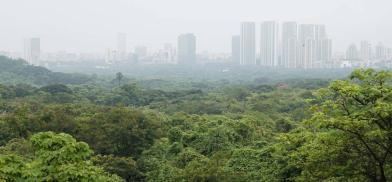Treachery at Aarey: Destroying Mumbai’s green lungs
The BJP and Metro Rail deny that Aarey is a forest. The real fear is that the builders will gradually convert the forest into a real estate bonanza, sooner or later

The BJP exploits Indian history, sings its glory but has no real understanding of Indian culture. As Rabindranath Tagore once said, India’s culture is rooted in its forests. Ours is an ‘Aranya sanskriti’(forest culture).
But the BJP has no respect for this culture. So, the first thing it did on the first day of coming to power in Maharashtra through an unholy alliance with Shiv Sena dissidents was to take over parts of the Aarey forest on the outskirts of Mumbai for the metro rail project.
This is in total defiance of a strong movement of citizens. Aarey has now become a rallying point for all, not just citizen-activists but common people as well.
Grabbing Aarey
The decision reversed the one taken by the previous Uddhav Thackeray government to protect the forest region of Aarey, which essentially is Mumbai’s green lungs. The decision came on a particularly inappropriate day for another reason. It was the first day of the month of Ashadh, the Kalidasa Day, which honours the Sanskrit poet-dramatist Kalidasa. He wrote about the beauty of nature and environment and forests as few others have, through his immortal works like Meghaduta, the classic poem, and the play Shakuntala.
As Tagore pointed out, contemporary Western civilization is built of brick and wood. It is rooted in the city. But Indian civilization has been distinctive in locating its source of regeneration, material as well as intellectual, in the forests, not the city.
India's best ideas have come where man was in communion with trees and rivers and lakes, away from the crowds. The peace of the forest has helped the intellectual evolution of man. The culture of the forest has fuelled the culture of Indian society. The culture that has arisen from the forest has been influenced by the diverse processes of renewal of life, which are always at play in the forest, varying from species to species, from season to season, in sight and sound and smell. The unifying principle of life in diversity, of democratic pluralism, thus has become the principle of Indian civilization.
Indian civilization
Not being caged in brick, wood and iron, Indian thinkers were surrounded by and linked to the life of the forest. The living forest was for them their shelter, their source of food. The intimate relationship between human life and living nature became the source of knowledge. Nature was not dead and inert in this knowledge system. The experience of life in the forest made it adequately clear that living nature was the source of light and air, of food and water.
As Tagore wrote in “The Religion of the Forest," the ideal of perfection preached by the forest dwellers of ancient India runs through the heart of our classical literature and still influences our minds. The forests are sources of water and the storehouse of a biodiversity that can teach us the lessons of democracy; of leaving space for others whilst drawing sustenance from the common web of life.
The BJP and Metro Rail authorities are busy denying that Aarey is a forest. It is just a grassland come up on the land of the Aarey milk dairy in the 1950s to feed the cattle, they say. A recent video also makes such a claim but unwittingly, it mentions there are lakhs of trees on the land which will not be untouched by the Metro car shed sought to be constructed there.
Builders’ world
But the real fear is that the authorities with their nexus with the builders will gradually convert the forest into a real estate bonanza, sooner or later. The Metro rail connection will be a real boon for this land grab.
We should have no doubt that Aarey in Mumbai was and is a forest. Here is something Homi Taleyarkhan, a former Maharashtra Minister and a nature lover, wrote about Aarey way back in the 1950s” “One could hardly believe that there could be so much forest so near Bombay, so wealthy in its variety, in its sights and sounds.”
Taleyarkhan, who was also a former Governor of Sikkim, wrote this and much more in his book ‘Escape from the City’ published by Popular Book Depot in 1954.
If you are looking for something off the beaten track, then make this delectable trip from Aarey to Kanheri National Park through the woods, he says. The road winds and twists through the thick forest. Interestingly, Taleyarkhan gives the credit for discovering the track to “our nature-loving and aesthetic minded minister for education and parks, Dinkarrao Desai.” Till then nobody knew of the sheer beauties that lay hidden in these thick woods.”
Loving nature
This is a four-page chapter. He also gives directions about approaching the trek. You should get off at Goregaon station and then take an “anna bus” (an “anna”, earlier in use, was the small currency, one-sixteenth of a rupee) to Aarey and then start walking. The road was then not fit enough for a car; it was ok for a jeep.
He writes about the tall trees, wild flowers, bushes and shrubs, birds singing and colourful and numerous little surprises.
This is a fascinating book, my copy is a bit moth eaten but I now realize it is a bit of a treasure because the writer is not a touristy-type but a real traveller. He says rightly that the real delight of an outing lies in a good walk at the end of your vehicular journey.
The new Chief Minister, Eknath Shinde, should have a better sense of the environment as he comes from Satara district with its lovely Koyna dam and the forest area.
Blind CM?
And what is the use of the new Metro and the Aarey shed to the Chief Minister’s assembly constituency of Thane, the Mumbai suburb? It will take years for the Metro project to reach Thane and other areas. He was the urban development minister in the last ministry but public bus transport remains inadequate in his own constituency.
Satara has a rich tradition. It was in this district that Krantisimha (the revolutionary lion) Nana Patil formed a parallel government during the British rule. The honorific title was given to Patil out of love by the people for his revolutionary fervour. As against his revolution, what Shinde has done can be termed by some as a counter revolution.
Maratha history is full of incidents of treachery so the word ‘Fitur’, treachery, constantly figures in writing on the period in Marathi. People from Satara district are generally thought to be simple and hardy. As coincidence would have it, I was talking with a lawyer representing a company in a labour dispute raised by Mathadi workers (loaders) who hail from Satara. Though he represents the management, he was full of praise for the Mathadis; they are absolutely honest, and will not take a scrap from the factory.
Shinde has one common physical feature with these men. He is broad shouldered. He must have been a simple man once but politics can change one completely. Otherwise, you cannot build two helipads in your village which lacks basic amenities.
(The author is a senior journalist and culture critic. Views are personal. By special arrangement withThe Billion Press)











Post a Comment